

SCS Engineers is a Bronze Sponsor of Air & Waste Management Association’s 117th ACE 2024 Conference, June 24-27, at the Calgary TELUS Convention Centre in Calgary, Alberta, Canada.
The theme is “Emissions Reductions for Sustainable Energy Futures.”
SCS Engineers is hosting two booths at ACE 2024 – so swing by #102 and #104 to talk with our air and waste management experts and see demonstrations of advanced remote monitoring and control (RMC) software! Talk with Pat Sullivan, Mike McLaughlin, Carrie Ridley, Melissa Russo, Ryan Thomas, Ketan Shah, Stephanie Taylor, Evelyn Martinez, and David Greene about how SCS can find solutions for your air and waste management challenges.
Several of our professionals are presenting, including:
The Canadian Prairies region is a fast-growing area with many important exports including oil and gas, agriculture, and timber. In addition, this region spans many latitudes and encompasses many biomes including Grassland, Parkland, Foothills, Boreal Forest, Rocky Mountains, and the Canadian Shield. With this diversity in ecosystems and major exports comes a plethora of challenges. A calculated balance between resource development, social responsibilities, and environmental stewardship is needed; this makes the region a hotspot for emissions reductions and technological innovations.
Calgary is excited to host ACE 2024, bringing industry, academia, and policymakers together so that we can learn, collaborate, and most importantly, improve environmental knowledge and decision-making in this unique landscape which is at the forefront of global change. Alberta’s industries are constantly adapting, creating, and incorporating new technologies for responsible and sustainable development, with a focus on renewable and alternative resources. The global community will find Calgary, Alberta, and Canada a nexus for emerging ideas, innovations, and solutions in the field of environmental stewardship that are applicable worldwide.
Online registration is now open! Click here for more conference details
We hope to see you there!
While performing methane reduction operations and monitoring at the Anchorage Regional Landfill in Alaska, members of the SCS RMC drone team met some pretty amazing people, including Shane Christiansen who works for the Municipality of Anchorage. The RMC team got to know Shane and learned how he and his business partner, Tim Harrington, are helping disabled children.
Shane and Tim run an organization called Children Leaving Tracks (CLT) that has the mission of providing mobile technologies to young people with limited mobility, allowing them to participate more fully in everyday activities with their peers. They believe that providing improved mobility can expand the physical and mental well-being of these kids and offer them greater freedom and quality of life.
Moved by Shane and Tim’s passion and dedication, SCS made a donation, which will provide “Electric All-Terrain Trikes” to three children! “Everyone deserves to have these experiences in life, but unfortunately this kind of technology is not always covered by insurance companies,” says Shane. “This means that some people go their entire life without getting to enjoy all that it has to offer. They don’t have the freedom to [move about] as they please.”
Although still in the early stages, Children Leaving Tracks seeks financial and in-kind donations from sponsors and networking partners. They are working toward creating a corporate/private collaboration that has the single mission of helping disabled children become more mobile for their health and personal growth.
CLT uses funding to run the organization to supply and finance Track Chairs and Electric Trikes. Donations cover the costs of purchasing and shipping these chairs to the kids who need them. Shane and Tim are registering Children Leaving Tracks as a 501c3 non-profit company; they are also starting a parent company aimed to be the primary funding arm that will supply a percentage of revenues from more recreational products it plans to develop.
The ultimate goal is to change the lives of hundreds of children by opening up their world through greater mobility and freedom. The organization helps youngsters gain confidence, better mental and physical health, and create greater opportunities to expand their individual talents. Kudos to Children Leaving Tracks!
Learn more about how this inspirational organization uses new technology to make life better; or to help, please contact Shane Christiansen at 1-907-529-5153.
If you would like to know more about using technology to improve the environment, ask SCS click here.
Sam’s contributions help the waste industry reduce environmental and health risks. His work improves the quality of life for workers in the industry and the communities surrounding our waste facilities.
Sam develops remote monitoring and control (RMC) SCADA systems that meet environmental management needs at landfills and industrial facilities. Operators can monitor and control their landfill equipment (e.g., flares, blowers, pumps, tanks, etc.) from anywhere using their phone or computer.
During COVID, he implemented RMC systems enabling operators to continue running essential services safely without physically traveling to the facility, and are especially valuable when facing labor shortages.
SCS is proud of our five candidates submitted for consideration this year. We’ve never submitted so many before; it’s a wonderful indicator of the talented professionals working at SCS, where company ownership spurs creativity and leaders. See our previous winners here.
San Bernardino County’s almost 500-acre San Timoteo landfill upgraded with gas monitoring and controls that manage its four blowers, flare station, pumps, valves, thermocouples, and other devices. There are 340 tags, 16 screens and more than 50 alarms monitored and managed by web-based SCADA software. Simpler, streamlined SCADA is more capable and closely connected, and less costly for landfill gas monitoring and control.
San Timoteo added options such as 3D imaging from flying drones and augmented reality (AR) displays. After flying the site, the imagery is uploaded to update its map and create point-cloud graphics. Aerial data is used to create topographic mapping, 2D images, 3D renderings, and GIS, thermal and tunable diode laser (TDL) images for methane leak detection.
Landfill operators and managers can remotely view the site using a mobile device, and “walk the site” from their offices or anywhere using the HoloLens.
Now nearly all landfills can afford to gather data with Ethernet and wireless networking, analyze data with sophisticated software, and display it on ubiquitous interfaces including tablet PCs and smartphones. The trick is applying the technologies in applications that enable more effective decisions.
Read the article in Control Magazine.
Watch a quick video at San Timoteo.
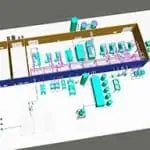
SCS is receiving the Gold Business Achievement Award for a Large Environmental Firm, for outstanding business performance in 2019. We largely attribute our organic growth to our clients interested in Sustainable Materials Management (SMM) and renewable natural gas (RNG) services. Our SMM programs increase our clients’ solid waste management efficiencies, reduce waste, and support sustainable recycling, and our design and design/build facilities convert landfill gas, dairy digester gas, and wastewater treatment plant digester gas to RNG. In addition, SCS’s Geographic & Practice Area Expansion initiative in 2019 enables us to expand our professional engineering and consulting services for liquids management, wastewater treatment, and emerging contaminants from new offices in the South, Central, and Midwest regions of the United States.
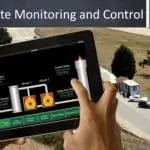
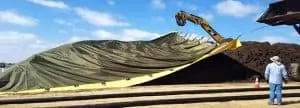
The Environmental Services Division of the city of San Diego, in collaboration with SCS Engineers, is receiving the Composting Project Merit Award in recognition for the composting operation at the Miramar Landfill in San Diego. In collaboration with the City, SCS designed an innovative covered Aerated Static Pile (ASP) composting system that will divert 100,000 tons per year of organic waste from the landfill. The ASP became operational in August 2019 and will compost 40,000 tons per year into useful by-products (and has capacity for an additional 20,000 tons). It provides an enhanced stormwater control system, and will eventually run on renewable energy generated from the landfill. According to the StopWaste.com calculator, the upgrade reduces greenhouse gas emissions by the equivalent of removing 19,015 cars from the road.
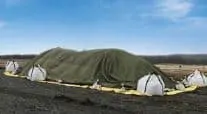
In addition, the recent announcement of SCS’s ASP Composting Pilot Program is making headlines. SCS owns a covered ASP compost system that is mobile and can be set-up on sites within an area of 50 feet by 100 feet, or less. In the covered ASP compost system, process and odor control is pro-active with a shorter composting period. Pilot tests allow waste managers to assess composting and to see if it is the right fit for their situation. The ASP system processes material batches in two months. Additional batches or “recipes” can test in 2-month intervals.
“Managing air, water, and soil pollution prevention are driving state and local regulations,” said Bob Gardner, a Senior Vice President of SCS Engineers. “Offsetting as much of the cost by improving operations, lowering energy consumption, and switching to renewable energy resources is critical to our clients.”
About SCS Engineers
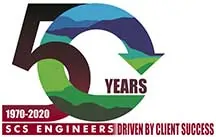 SCS, an employee-owned environmental consulting and construction firm, is celebrating our 50th year in business. We are producing technologies and programs that lower industrial operating costs and reduce greenhouse gases for private and public clients who are establishing goals to reduce their environmental impact.
SCS, an employee-owned environmental consulting and construction firm, is celebrating our 50th year in business. We are producing technologies and programs that lower industrial operating costs and reduce greenhouse gases for private and public clients who are establishing goals to reduce their environmental impact.
Our technologies and programs are finding footholds in the agricultural, industrial, and manufacturing sectors as municipalities and companies aim to reach climate change goals without passing all of the expense to consumers. SCS clients entrust us with the management of more than 35 million metric tons of anthropogenic CO2e greenhouse gases every year. We collect and beneficially use or destroy enough to offset greenhouse gas emissions from 7.4 million passenger cars annually.
The Ignition Firebrand Awards recognize system integrators and industrial organizations that create innovative industry solutions.
SCS Engineers and partner Corso Systems jointly received a 2019 Firebrand Award yesterday at the annual Ignition Community Conference. The firms won recognition for their next-generation visualization and control system for landfills.
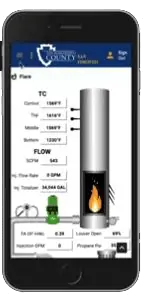
After flying the San Timoteo Landfill, uploading the imagery, and mapping the facility, they embed both the 2D images and 3D rendering into Perspective. The team can take those rendered images and apply them into a Microsoft HoloLens VR headset as well, which allows decision-makers at San Bernardino County to “walk the site” from their offices. Now, landfill executives and operators can view their sites remotely from any device, anywhere. Other benefits include:
The firms and SCS RMC® have received a tremendous amount of positive feedback. SCS RMC® is now rolling out similar solutions at more landfills, for pipelines, and other industrial applications. A video on the 2019 ICC Award website explains how the system works and what landfill owners and operators can expect.
Well done and congratulations on providing superior client service!
President, Washington DC Post of SAME
The Washington D.C. Post of the Society of Military Engineers (SAME) Board of Directors selected David Hostetter for his Outstanding Contributions by a Young Civilian Member.
Hostetter says he focuses on three things in his work: using his engineering skills to make a difference in the world, serving his clients wholeheartedly, and mentoring other young professionals as he was mentored.
Hostetter mentors other young professionals by involving them in hands-on engineering projects which helps them to discover how design impacts installation and operations. They have the opportunity to ask questions and to work with senior level engineers and experienced field staff. Dave learned valuable lessons this way, and he is passing those lessons and best practices on to others.
Hostetter is now the Eastern Regional Manager of SCS RMC®, which stands for remote monitoring and control technology. Several industries use this proven technology for the simultaneous viewing, analysis, alerting, and control of equipment and systems critical to production and safe operations.
Well done, Dave!
Read the press release or learn more about Dave Hostetter.